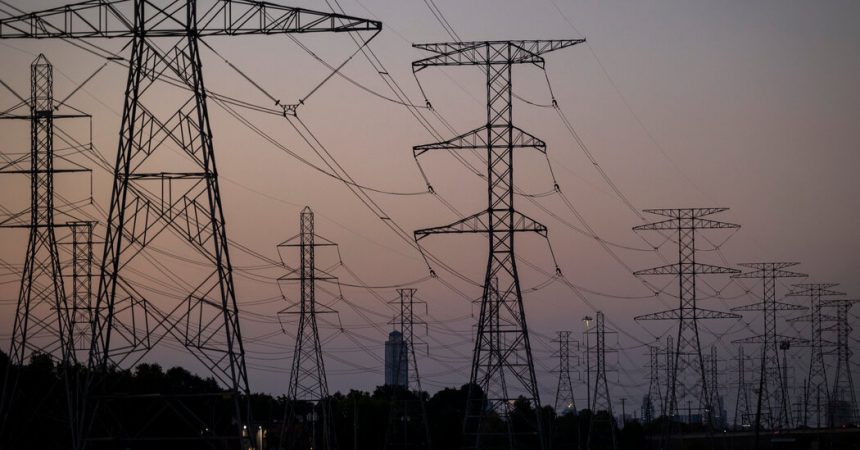The Biden administration on Tuesday released rules designed to speed up permits for clean energy while requiring federal agencies to more heavily weigh damaging effects on the climate and on low-income communities before approving projects like highways and oil wells.
As part of a deal to raise the country’s debt limit last year, Congress required changes to the National Environmental Policy Act, a 54-year-old bedrock law that requires the government to consider environmental effects and to seek public input before approving any project that necessitates federal permits.
That bipartisan debt ceiling legislation included reforms to the environmental law designed to streamline the approval process for major construction projects, such as oil pipelines, highways and power lines for wind- and solar-generated electricity. The rules released Tuesday, by the White House Council on Environmental Quality, are intended to guide federal agencies in putting the reforms in place.
But they also lay out additional requirements created to prioritize projects with strong environmental benefits, while adding layers of review for projects that could harm the climate or their surrounding communities.
“These reforms will deliver smarter decisions, quicker permitting, and projects that are built better and faster,” said Brenda Mallory, chair of the council. “As we accelerate our clean energy future, we are also protecting communities from pollution and environmental harms that can result from poor planning and decision making while making sure we build projects in the right places.”
The move comes as President Biden rushes to push through a slew of major environmental rules ahead of November’s presidential election, including policies to limit climate-warming pollution from cars, trucks, power plants and oil and gas wells; to protect the habitats of the sage grouse and other endangered species; to ban asbestos; and to remove so-called forever chemicals from tap water.
The rules announced Tuesday could help to more quickly carry out Mr. Biden’s signature climate law, the 2022 Inflation Reduction Act, which includes at least $370 billion in tax incentives to expand renewable energy, such as wind and solar power, as well as electric vehicles. Analysts say it could be difficult to fully realize the benefits of the law if, say, the construction of transmission lines needed for renewable energy or electric vehicle charging stations is bogged down in the permitting process.
The National Environmental Policy Act, known as NEPA, was signed into law by President Richard M. Nixon in 1970, after several environmental disasters, including a crude oil spill off the coast of Santa Barbara, Calif., and fires on the heavily polluted Cuyahoga River in Ohio, that shocked the nation.
For decades, the oil and gas, construction and real estate industries complained that the permitting requirements hindered business. Communities affected by major projects and environmental groups have often been able to use NEPA to delay or prevent projects from moving forward.
During his term as president, Donald J. Trump, a real estate developer, stripped away some of the protections under the environmental law, only to have Mr. Biden restore them.
Last year, as Mr. Biden sought Republican support for legislation to lift the federal debt ceiling, he agreed to speed up federal approvals for all kinds of projects, polluting or not. The new provisions include a requirement that the analyses of a project’s environmental impact be completed within two years. One recent government study found these analyses took an average of 4.5 years.
.
At the same time, the new rules released by the White House Council for Environmental Quality would allow projects that have a demonstrated long-term environmental benefit to receive expedited environmental reviews or bypass them altogether. Federal agencies would also be required to identify environmentally preferable alternatives to proposed projects early in the permit review process.
They also direct federal agencies to consider whether a proposed project would avoid or reduce the pollution that disproportionately affects low-income and minority communities.
“This is a big deal because for the first time it prioritizes projects that have climate change and or environmental justice benefits, such as transmission lines that bring renewable energy to market,” said Ted Bolling, an environmental lawyer who worked in the environmental quality council from the Clinton to the Trump administrations.
“When it’s time to permit a highway, agencies will be required to address the environmental justice effects of siting highways that split neighborhoods,” Mr. Bolling said.
Environmentalists roundly praised the rules.
“We are thrilled to see NEPA strengthened and restored,” said Sam Wojcicki, senior director of climate policy at the National Audubon Society. “The new climate and environmental justice provisions will result in more robust, more resilient projects, while ensuring that the voices of impacted communities are heard. Meaningful community engagement is critical for an equitable, sustainable, and lasting clean energy transition.”
The nation’s major business groups and the fossil fuel industry, including the Chamber of Commerce; the American Fuel and Petrochemical Manufacturers; the American Road and Transportation Builders Association; and the National Mining Association, wrote in public comments on the proposed rule that it was “a step in the wrong direction.”
The groups wrote that it would “increase the complexity of analysis that agencies will need to perform, reducing the efficiency of the environmental review process, delaying decision-making and ultimately blocking the realization of critical investments.”
The groups also criticized the Biden administration’s efforts to layer climate concerns onto one of the nation’s oldest environmental statutes. A future administration could erase those changes, portending “a never-ending cycle of regulatory reversals between administrations, eroding public confidence and depriving the business community and the public of the predictability needed for substantial investment in long-term projects.”
Studies show that the current cycle of “erase and replace” between Republican and Democratic administrations when it comes to environmental policy measurably harms the economy.
Mr. Trump, the presumptive Republican nominee, has promised to decimate much of Mr. Biden’s environmental legacy if re-elected to the White House. But finalizing the rules this spring gives them at least one layer of legal protection: According to statute, as long as the rule is published more than 60 legislative days before the end of the presidential term, it cannot be eliminated by a simple majority vote in Congress.






